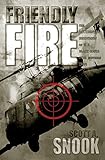Friendly Fire : The Accidental Shootdown of U.S. Black Hawks over Northern Iraq / Scott A. Snook.
Material type: TextPublisher: Princeton, NJ : Princeton University Press, [2011]Copyright date: ©2000Edition: Course BookDescription: 1 online resource (280 p.) : 1 table, 12 line illus., 6 halftonesContent type:
TextPublisher: Princeton, NJ : Princeton University Press, [2011]Copyright date: ©2000Edition: Course BookDescription: 1 online resource (280 p.) : 1 table, 12 line illus., 6 halftonesContent type: - 9780691095189
- 9781400840977
- Aerial reconnaissance, American -- Iraq
- Aerial reconnaissance, American -- Iraq
- Black Hawk (Military transport helicopter) -- Accidents -- Investigation
- Black Hawk Friendly Fire Incident, Iraq, 1994
- Friendly fire (Military science) -- Iraq
- Friendly fire (Military science) -- Iraq
- Leadership -- Case studies
- Leadership -- Case studies
- Organizational behavior -- Case studies
- Organizational behavior -- Case studies
- SOCIAL SCIENCE / Sociology / General
- 355.4/22
- UG765.I72 S63 2011
- online - DeGruyter
- Issued also in print.
| Item type | Current library | Call number | URL | Status | Notes | Barcode | |
|---|---|---|---|---|---|---|---|
 eBook
eBook
|
Biblioteca "Angelicum" Pont. Univ. S.Tommaso d'Aquino Nuvola online | online - DeGruyter (Browse shelf(Opens below)) | Online access | Not for loan (Accesso limitato) | Accesso per gli utenti autorizzati / Access for authorized users | (dgr)9781400840977 |
Frontmatter -- Contents -- List of Figures -- Preface -- Acknowledgments -- List of Abbreviations -- 1. Introduction: How in the World Could This Happen? -- 2. The Shootdown: A Thin Description -- Multiple Explanations: A Walk Through the Causal Map -- 3. Individual-Level Account: Why Did the F-15 Pilots Misidentify the Black Hawks? -- 4. Group-Level Account: Why Did the AWACS Crew Fail to Intervene? -- 5. Organizational-Level Account: Why Wasn't Eagle Flight Integrated into Task Force Operations? -- 6. Cross-Levels Account: A Theory of Practical Drift -- 7. Conclusions: There But by the Grace of God . . . -- Appendixes -- References -- Author Index
restricted access online access with authorization star
http://purl.org/coar/access_right/c_16ec
On April 14, 1994, two U.S. Air Force F-15 fighters accidentally shot down two U.S. Army Black Hawk Helicopters over Northern Iraq, killing all twenty-six peacekeepers onboard. In response to this disaster the complete array of military and civilian investigative and judicial procedures ran their course. After almost two years of investigation with virtually unlimited resources, no culprit emerged, no bad guy showed himself, no smoking gun was found. This book attempts to make sense of this tragedy--a tragedy that on its surface makes no sense at all. With almost twenty years in uniform and a Ph.D. in organizational behavior, Lieutenant Colonel Snook writes from a unique perspective. A victim of friendly fire himself, he develops individual, group, organizational, and cross-level accounts of the accident and applies a rigorous analysis based on behavioral science theory to account for critical links in the causal chain of events. By explaining separate pieces of the puzzle, and analyzing each at a different level, the author removes much of the mystery surrounding the shootdown. Based on a grounded theory analysis, Snook offers a dynamic, cross-level mechanism he calls "practical drift"--the slow, steady uncoupling of practice from written procedure--to complete his explanation. His conclusion is disturbing. This accident happened because, or perhaps in spite of everyone behaving just the way we would expect them to behave, just the way theory would predict. The shootdown was a normal accident in a highly reliable organization.
Issued also in print.
Mode of access: Internet via World Wide Web.
In English.
Description based on online resource; title from PDF title page (publisher's Web site, viewed 29. Jul 2021)


